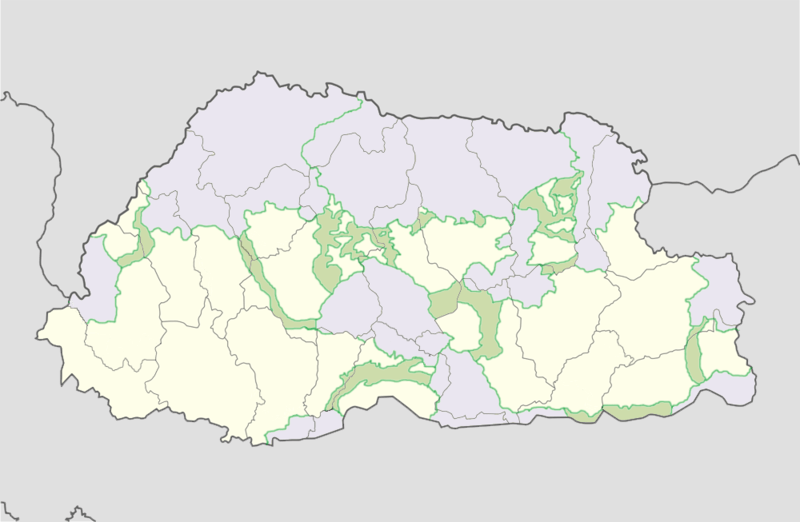Lhuntse District
Lhuntse District (Dzongkha: ལྷུན་རྩེ་རྫོང་ཁག་; Wylie: Lhun-rtse rdzong-khag; previously "Lhuntshi") is one of the 20 dzongkhag (districts) comprising Bhutan. It consists of 2506 households.[2] Located in the northeast, Lhuntse is one of the least developed dzhongkhags of Bhutan. There are few roads, the first gas station was opened in September 2005, electricity is not well distributed, and the difficult terrain makes distribution of social welfare problematic. Despite its favourable climate, farming is hindered by the lack of infrastructure.[3]
Lhuntse district ལྷུན་རྩེ་རྫོང་ཁག་ | |
|---|---|
District | |
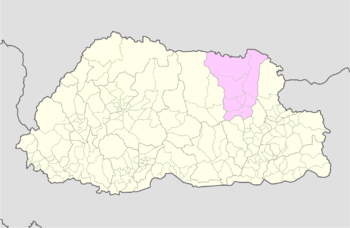 Map of Lhuntse District in Bhutan | |
| Country | Bhutan |
| Headquarters | Lhuntse |
| Area | |
| • Total | 1,944 km2 (751 sq mi) |
| Population (2017) | |
| • Total | 14,437 |
| • Density | 7.4/km2 (19/sq mi) |
| Time zone | UTC+6 (BTT) |
| HDI (2017) | 0.619[1] medium · 6th |
| Website | lhuentse |
Culture
Lhuntse is culturally part of eastern Bhutan. The languages and lifestyle of its inhabitants may be contrasted against the dominant western Ngalop culture.
This region is renowned as a textiles producing region and as the ancestral homeland of the Bhutanese royal family.[4]
Alcohol
Eastern Bhutanese culture is distinctive in its high alcohol consumption in relation to other parts of Bhutan. Ara, the traditional alcohol of Bhutan, is most often home made from rice or maize, either fermented or distilled.[5] It may only be legally produced and consumed privately. Ara production is unregulated in method and quality. Its sale has been prohibited in Bhutan and enforced since a severe crackdown. However, because Ara returns far more profit than other forms of maize, many Bhutanese farmers have pressed for legal reform.[6]
The Bhutanese government, meanwhile, is intent on discouraging excessive alcohol consumption, abuse, and associated diseases through taxation and regulation.[7][8]
Through government efforts to reduce ara production and consumption in Lhuntse District, locals conceded in 2011 that something should be done to curb the distinctly eastern Bhutanese tradition of heavy drinking. The government's strategy is to reduce ara production and consumption gradually until it is eliminated. Alcoholism and ara production have been notable topics of political discussion Bhutan, especially at the local level.[9] Ara, however, is culturally relevant for its religious and medicinal uses.[10][11] In 2011, the government passed its Alcohol Control Regulation, which imposed up to three times the previous taxes on alcohol. As a result, alcohol sales have dropped and prices have risen.[12][13]
Languages
Lhuntse is home to a variety of language groups. In the east, Dzala an East Bodish language, is spoken. In southern Lhuntse, Chocangacakha, a sister language to Dzongkha, is spoken. The northern and western parts of the district are known as the Kurtö region, where inhabitants speak the East Bodish Kurtöp language.[14]
Administrative divisions
Lhuntse District is divided into eight village blocks (or gewogs):[16]
Within these divisions are individual villages withy small populations such as Autsho.
Geography
Most of Lhuntse District is part of the environmentally protected areas of Bhutan. The district contains parts of Wangchuck Centennial Park in the north (the gewogs of Gangzur, Khoma and Kurtoe), Thrumshingla National Park in the south (the gewogs of Gangzur, Jarey and Metsho), and Bumdeling Wildlife Sanctuary in the east (the gewogs of Khoma and Minjay). These three parks are connected by biological corridors that crisscross the central and southern regions of the district.[15]
Gallery
 Back side view Lhuentse Dzong
Back side view Lhuentse Dzong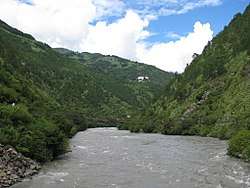 Kuri Chu river flowing below the Lhuentse Dzong
Kuri Chu river flowing below the Lhuentse Dzong Chorten below Lhuentse Dzong
Chorten below Lhuentse Dzong Close view of Chorten
Close view of Chorten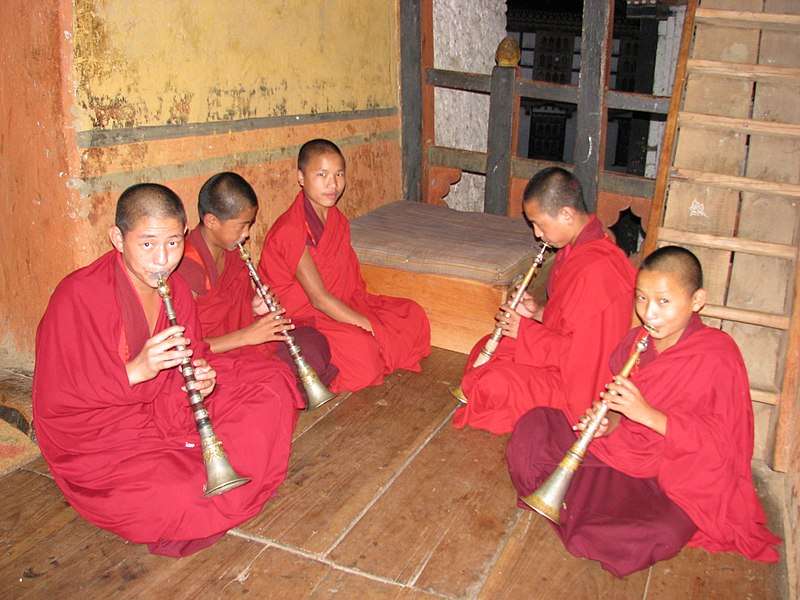 Musician monks
Musician monks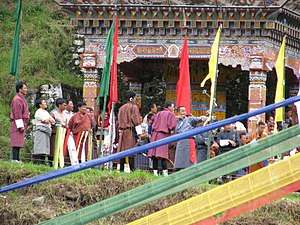 Archery tournament at Lhuentse Dzong
Archery tournament at Lhuentse Dzong On the weaver's loom
On the weaver's loom A weaver at work
A weaver at work
Towns and settlements in Lhunste District
References
- "Sub-national HDI - Area Database - Global Data Lab". hdi.globaldatalab.org. Retrieved 2018-09-13.
- Royal Government, Ninth Plan, pg. 2
- "Lhuentse Dzongkhag: Ninth Plan (2002-2007)" (PDF). Government of Bhutan. Archived from the original (PDF) on 2004-10-22. Retrieved Nov 28, 2005.
- Peabody Essex Museum (1994). Diana K. Myers, Susan S. Bean (ed.). From the land of the thunder dragon: textile arts of Bhutan. Serindia Publications. pp. 110, 176.
- Mowe, Sam (2011-06-02). "Making Moonshine: How to Make Bhutanese Rice Wine". Tricycle online. Retrieved 2011-07-27.
- Wangdi, Tempa (2011-01-27). "Ara Production and Sale Should Be Legalized, Farmers Say". Bhutan Observer online. Archived from the original on 2011-07-25. Retrieved 2011-07-27.
- Namgyal, Gyembo (2011-03-15). "Reduce Alcohol Abuse, Lyonchhen Urges Local Leaders". Bhutan Observer online. Archived from the original on 2012-04-03. Retrieved 2011-07-27.
- Namgyal, Gyembo (2011-07-18). "Alcohol Price Hike Doesn't Quite Discourage Drinking". Bhutan Observer online. Archived from the original on 2011-07-26. Retrieved 2011-07-27.
- Wangchuck, Jigme (2011-09-05). "Ara Faces Banishment in Lhuentse". Bhutan Observer online. Archived from the original on 2011-09-07. Retrieved 2011-09-08.
- Namgyal, Gyembo (2010-01-19). "It is Lhasoel Time in the East". Bhutan Observer online. Archived from the original on 2011-01-20. Retrieved 2011-07-27.
- Dema, Tashi (2007-06-04). "Trongsa: Slithering with Snakes". Kuensel online. Archived from the original on 2012-04-02. Retrieved 2011-07-27.
- Wangchuck, Jigme (2011-05-10). "Regulation and Duty Hit Bars". Bhutan Observer online. Archived from the original on 2011-07-13. Retrieved 2011-07-14.
- Lhadon, Pema (2011-07-13). "Drinking Habit Peaks at the Peak of Learning?". Bhutan Observer online. Archived from the original on 2011-07-13. Retrieved 2011-07-14.
- van Driem, George L. (1993). "Language Policy in Bhutan". London: SOAS. Archived from the original (PDF) on 2010-11-01. Retrieved 2011-01-18.
- "Parks of Bhutan". Bhutan Trust Fund for Environmental Conservation online. Bhutan Trust Fund. Archived from the original on 2011-07-02. Retrieved 2011-03-26.
- "Chiwogs in Lhuentse" (PDF). Election Commission, Government of Bhutan. 2011. Archived from the original (PDF) on 2011-10-02. Retrieved 2011-07-28.
